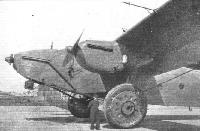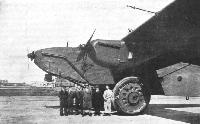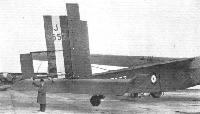
Описание
Страна : Великобритания
Год : 1928
Единственный экземпляр
Тяжелый транспортный самолет
Варианты
- Rohrbach - Ro.II - Ro.IV - 1923 - Германия
- Beardmore - Inflexible - 1928 - Великобритания
Beardmore Inflexible
В 1925 году, после приобретения лицензии на конструкцию Рорбаха с гладкой несущей обшивкой, компания "William Beardmore & Co. Ltd" получила заказ на два больших гидросамолета и еще на несколько - с сухопутным шасси. Гидросамолеты, каждый с двумя двигателями Napier Lion, были построены фирмой "Rohrbach Metal Aeroplane Co. A/S" в Копенгагене и отправлены в Феликстоув для оценки. Там ему дали имя Beardmore Inverness.
В Великобритании инженеру фирмы "Beardmore" У. С. Шеклтону поручили создать более крупный самолет с сухопутным шасси Beardmore Inflexible. Детали его конструкции доставляли автотранспортом в экспериментальный центр авиации и вооружения (А&АЕЕ) в Мартлешем-Хит для сборки, 5 марта 1928 года машина впервые поднялась в воздух. Первый полет показал, что Inflexible слишком тяжел для имеющейся силовой установки из трех двигателей Rolls-Royce Condor.
Машину показали военным на британской авиабазе Хэндон 30 июня 1928 года, впоследствии ее разобрали в Мартлешем-Хит, где до конца 1930 года она использовалась для исследований воздействия коррозии.
ТАКТИКО-ТЕХНИЧЕСКИЕ ХАРАКТЕРИСТИКИ
Beardmore Inflexible
Тип: тяжелый транспортный самолет
Силовая установка: три V-образных двигателя Rolls-Royce Condor мощностью по 650 л.с. (485 кВт)
Летные характеристики: максимальная скорость на оптимальной высоте 175 км/ч
Масса: максимальная взлетная 16783 кг
Размеры: размах крыла 48,01 м; длина 23,01 м
Описание:
- Beardmore Inflexible
- Flight, April 1928
THE BEARDMORE "INFLEXIBLE” - Flight, July 1928
BEARDMORE "INFLEXIBLE”
Фотографии
-
Air International 1974-03 / Plane facts
Регистрационный номер: J7557 [26] -
Flight 1930-01 / Flight
Регистрационный номер: J7557 [26] Один Rohrbach Ro VI в середине 1920-х годов был построен компанией "Beardmore". Ro VI с размахом крыла 48,00 м до начала Второй мировой войны оставался самым большим британским сухопутным самолетом. Самолет получил серийный номер J7557, утилизировали его в 1930 году.
The Beardmore "Inflexible" was an interesting experiment in size. Its wing span was more than 150 ft. Like a good many other very large machines, the weight of the structure was somewhat great, and the useful load correspondingly reduced. Nevertheless, the machine has been flown in public on several occasions, attracting great attention. -
Мировая Авиация 82
Регистрационный номер: J7557 [26] 5 марта 1928г.: впервые взлетел самолет "British Beardmore Inflexible", оснащенный тремя двигателями Rolls-Royce Condor по 650 л. с. (484 кВт).
Видна фиксированная балансировочная поверхность на законцовке крыла. -
Aeroplane Monthly 1990-03 / P.Jarrett - Beardmore's heavy metal monsters (2)
Регистрационный номер: J7557 [26] The sole example of the Beardmore Inflexible built to investigate the possibilities of what were considered (in the 'twenties) to be ultra-large all-metal monoplanes.
Another view of the Inflexible taken at Martlesham Heath around October 1929. Note the wing’s deep aerofoil section. -
Aeroplane Monthly 1990-03 / P.Jarrett - Beardmore's heavy metal monsters (2)
Регистрационный номер: J7557 [26] The Inflexible photographed at RAF Martlesham Heath circa October 1929. It still carries its “Neto Type" number from the previous year's Hendon display, and a distinctive paint scheme - apparently in RAF roundel colours - on its wheels.
-
Aeroplane Monthly 1990-03 / P.Jarrett - Beardmore's heavy metal monsters (2)
Регистрационный номер: J7557 [26] The Inflexible pictured at RAF Martlesham Heath in early 1928. Note the handling dollies alongside.
-
Aeroplane Monthly 1990-03 / P.Jarrett - Beardmore's heavy metal monsters (2)
Регистрационный номер: J7557 [26] The Inflexible at RAF Martlesham Heath early in 1928, on the dollies which enabled it to be moved sideways into its hangar.
-
Flight 1928-06 / Flight
Регистрационный номер: J7557 [26] Самолет Inflexible с гражданским номером G-EBNC закончил свою карьеру в качестве испытательной модели для изучения коррозии.
BEARDMORE "INFLEXIBLE": Transport Monoplane, with three Rolls-Royce "Condor" Engines. -
Flight 1928-06 / Flight
Регистрационный номер: J7557 [26] -
Flight 1928-04 / Flight
Регистрационный номер: J7557 [26] THE BEARDMORE "INFLEXIBLE": With a wing span of 158 ft., and a total loaded weight of about 15 tons, this machine is an interesting experiment in beating the scale law. Three-quarter front and three-quarter rear views.
-
Flight 1930-05 / Flight
Регистрационный номер: J7557 [26] DIGNITY AND IMPUDENCE: The Gadfly goes to bed beneath the nose of the Inflexible!
Другие самолёты на фотографии: Henderson & Glenny HSF.2 Gadfly - Великобритания - 1929
-
Aeroplane Monthly 1990-03 / P.Jarrett - Beardmore's heavy metal monsters (2)
Регистрационный номер: J7557 [26] The Inflexible al Conington in June 1929 with Glenny and Henderson Gadfly G-AAEY nestling under its nose. The Gadfly's empty weight was 17 per cent of that of the Inflexible!
Другие самолёты на фотографии: Henderson & Glenny HSF.2 Gadfly - Великобритания - 1929
-
Flight 1928-04 / Flight
Регистрационный номер: J7557 [26] The Beardmore "Inflexible": A view of the three Rolls-Royce "Condor" engines. The man standing in front gives a good idea of the size of the machine. Note particularly the large Dunlop wheels.
-
Flight 1928-07 / Flight
Регистрационный номер: J7557 [26] The Inflexible photographed at RAF Martlesham Heath early in 1928. The central figure in the group dwarfed by the port wheel is Sqn Ldr Rollo A. de Haga Haig.
-
Aeroplane Monthly 1990-03 / P.Jarrett - Beardmore's heavy metal monsters (2)
Регистрационный номер: J7557 [26] A couple of mechanics lend scale to the huge wheels of the Inflexible. The weight of the wheels increased by 70lb each when the tyres were inflated!
-
Aeroplane Monthly 1990-03 / P.Jarrett - Beardmore's heavy metal monsters (2)
Регистрационный номер: J7557 [26] J7557 at the Cambridge Aero Club's display at Conington on June 10-11, 1929.
-
Aeroplane Monthly 1974-09 / ??? - Hendon Pageantry 1920-37
Регистрационный номер: J7557 [26] The huge Beardmore Inflexible, 1928.
-
Flight 1928-07 / Flight
Регистрационный номер: J7557 [26] EXTREMES: Beardmore "Inflexible" (Condors) leading the parade.
-
Aeroplane Monthly 1990-03 / P.Jarrett - Beardmore's heavy metal monsters (2)
Регистрационный номер: J7557 [26] EXTREMES: Beardmore "Inflexible" (Condors) in flight
The Inflexible at the RAF Display at Hendon on June 30, 1928. -
Aeroplane Monthly 1990-03 / P.Jarrett - Beardmore's heavy metal monsters (2)
Регистрационный номер: J7557 [26] The Inflexible flying at the Norfolk and Norwich Aero Club Whitsun meeting in May 1929.
-
Aeroplane Monthly 1990-03 / P.Jarrett - Beardmore's heavy metal monsters (2)
Регистрационный номер: J7557 [26] The photograph was taken during the aircraft's appearance at the Norfolk and Norwich Aero Club's Whitsun display in May 1929.
-
Flight 1929-05 / Flight
Регистрационный номер: J7557 [26] NORWICH AIR DISPLAY: The Beardmore "Inflexible" monoplane of 1950 h.p.
-
Aeroplane Monthly 1990-03 / P.Jarrett - Beardmore's heavy metal monsters (2)
Регистрационный номер: J7557 [26] The view depicts J7557 taking part in the RAF Display at Hendon on June 30, 1928.
-
Air Pictorial 1977-04 / E.Rees - D.H.71 Tiger Moth /Prototypes and Experimentals/
Регистрационный номер: J7557 [26] The first de Havilland D.H.71 Tiger Moth, G-EBQU, dwarfed under the nose of the Beardmore Inflexible, at the 1928 R.A.F. Hendon Air Display
Другие самолёты на фотографии: De Havilland Tiger Moth / D.H.71 - Великобритания - 1927
-
Flight 1928-04 / Flight
Регистрационный номер: J7557 [26] The Inflexible's tail unit, showing the large Flettner tab and balance on the rudder and the rubber-in-tension tailwheel shock absorber.
-
Aeroplane Monthly 1990-03 / P.Jarrett - Beardmore's heavy metal monsters (2)
Регистрационный номер: J7557 [26] A rare photograph showing the Inflexible assembled in William Beardmore’s Dalmuir factory in 1927.
-
Aeroplane Monthly 1990-03 / P.Jarrett - Beardmore's heavy metal monsters (2)
Beardmore Inflexible
- Фотографии


























